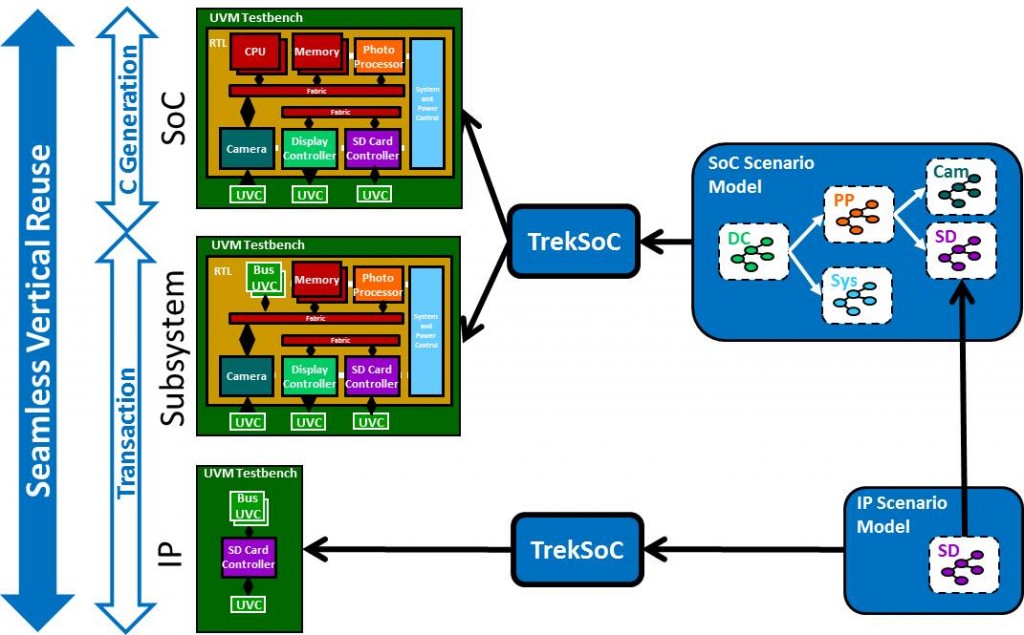
The Breker Trekker Tom Anderson, VP of Marketing
Tom Anderson is vice president of Marketing for Breker Verification Systems. He previously served as Product Management Group Director for Advanced Verification Solutions at Cadence, Technical Marketing Director in the Verification Group at Synopsys and Vice President of Applications Engineering at … More » Verification Reuse from Transactional Testbenches to Embedded C CodeJuly 30th, 2014 by Tom Anderson, VP of Marketing
In our previous two posts, we went into considerable detail on the vertical reuse of verification information from IP block to subsystem to system. We have focused on how graph-based scenario models enable simple composition as you move up the design hierarchy. This type of reuse is not possible with traditional testbench elements such as UVM scoreboards and virtual sequencers. Once again, this is not a slam against the UVM, but rather a basic trait of constrained-random testbenches. We skimmed over one aspect of vertical reuse: the transition from a “headless” SoC subsystem with no CPU to full-chip simulation with our automatically generated multi-threaded C test cases running on the SoC”s embedded processors. We also skipped the question of whether or not our graph-based scenario models can generate full-chip tests for chips that do not contain processors and are not classified as SoCs. This post links these ideas together and answers the question. Let’s start with a reminder of how vertical reuse works with TrekSoC:
In this case, each processor is replaced by UVM verification component (UVC) that executes the processor bus protocol. The processor bus effectively becomes another I/O port to the chip, with the UVC operating much like like a UVC for the camera, display, and SD card ports in this example. There is a subtle difference: the bus cycles generated need to resemble those that would be generated by the actual processors running code. The whole point of generating C test cases for an SoC is that the processors are in charge. They must configure the IP blocks and set up the use cases that tie multiple IP blocks together. When the processors are removed, the bus UVC has to perform this task. This is possible because the same scenario model that drives the C generation also drives the transactional connections to the UVCs in testbench. All stimulus, results checking, and system coverage derives from the scenario model. So we know that TrekSoC is smart enough to handle processor code, headless processor bus interfaces, and peripheral interfaces such as SD card, USB, or PCI Express. We’ve skipped over the question of whether we can verify a design that has no notion of a central processor that we can program. There are many examples of such designs, especially in networking and telecommunications. While some types of modems, switches, and routers have processors, many do not. Can TrekSoC verify these non-SoC designs? The answer is a resounding “yes!” After all, TrekSoC already has to understand how to talk to non-processor peripheral interface UVCs in the UVM testbench. If the design has only those interfaces, there is no requirement that a processor or processor bus must be involved. In our next blog post, we’ll talk more about how we accomplish this. In the meantime, we’d love to find a good term for large, complex chips that do not contain processors and are not SoCs. We have yet to discover a name we like. Please put your thinking cap on! Tom A. The truth is out there … sometimes it’s in a blog.
Tags: Accellera, Breker, coverage, EDA, functional verification, graph, portable stimulus, pwg, reuse, scenario model, scoreboard, sequencer, SoC verification, standards, UVC, uvm, working group Warning: Undefined variable $user_ID in /www/www10/htdocs/blogs/wp-content/themes/ibs_default/comments.php on line 83 You must be logged in to post a comment. |
|
|
|||||
|
|
|||||
|
|||||







